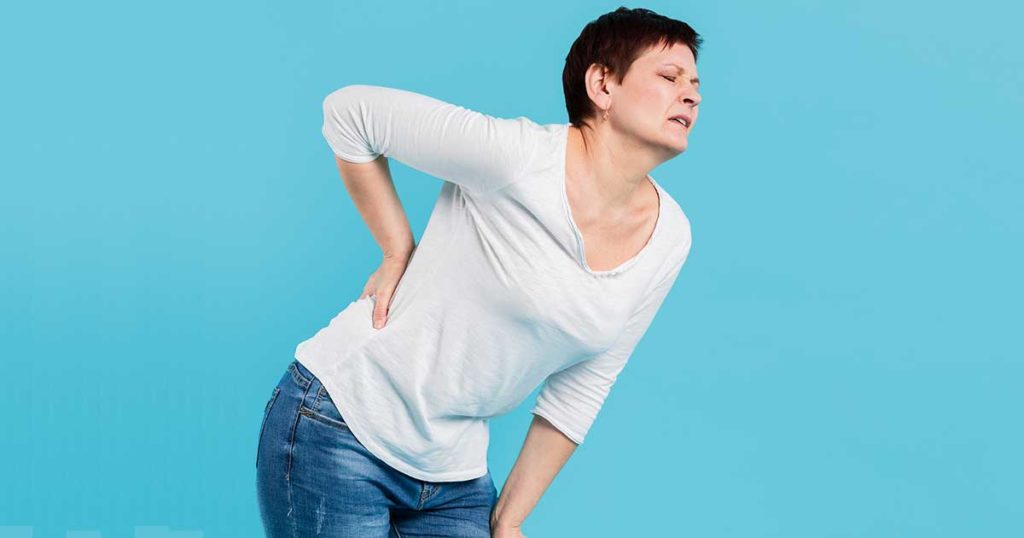Every second person has it more or less often and strongly in the back. Here are common problems and solutions.
Lumbago
Lumbago is not a disease in itself, but the result of other problems, such as a blocked joint. The body reacts to this with painful tension in the lower back muscles.
Symptoms: From one second to the next, the pain shoots into the lumbar region. You feel paralyzed, you can hardly move.
SOS tips: A pain pill stimulates mobility. Then, to relieve the strain, put your legs up so that your thighs form a 90-degree angle with your back and calves. Warmth (e.g. red light, hot bath) stimulates blood circulation.
When to the doctor If the symptoms do not subside, but persist for more than three weeks at the same level.
Disc prolapse
With age, the ring of fibrous cartilage that surrounds the disc becomes more fragile. Consequence: The soft mass inside shifts towards the fiber ring, bulges it out, or even breaks it completely. It then presses on the spinal nerve located in the spinal canal.
Symptoms: sharp pain in the neck, upper, or lower back. They can radiate into the fingers or feet.
SOS tips: Anti-inflammatory agents such as ibuprofen or diclofenac, but also paracetamol, can help. And move around as best you can. To lie down in bed and take it easy, as you used to do, is rather unfavorable for the healing process.
When to the doctor For persistent pain that lasts for four weeks. In the event of paralysis, muscle weakness, or additional incontinence, there is an emergency – then see a doctor immediately!
Tension
They are often at the beginning of other back problems. The main triggers are poor posture and excessive strain, which lead to circulatory disorders in the muscles. This then tenses up.
Symptoms: painful indurations, especially in the upper part of the back. Sometimes palpable lumps are also formed.
SOS tips: Whether heating or cherry stone pillows – warmth ensures a better supply of the muscles with oxygen and nutrients as well as a faster removal of metabolic products. Careful massages are also good.
When to the doctor If the symptoms have not subsided after about four weeks of self-treatment.
Osteoarthritis
This problem is the wear and tear of two vertebral bodies including the intervertebral disc between them (osteochondrosis). It hardens and shrinks. Bony attachments can form that irritate nerves. If the small vertebral joints are affected, one speaks of a facet joint osteoarthritis.
Symptoms: severely restricted mobility in the neck area. If nerves are also irritated, this can lead to torticollis and headaches. If the thoracic spine is affected, it is often painful to breathe. In the lumbar spine area, the pain sometimes radiates to the buttocks or the back of the thighs. You can feel the symptoms especially in the morning, immediately after getting up. The spine has to bear the body weight again and collapses a little.
SOS tips: Painkillers – and keep moving. Preparations with devil’s claw (pharmacy) are suitable for long-term treatment.
When to the doctor If the pain is no longer bearable after six weeks of self-therapy.
Osteoporosis
The cause is an increasing loss of bone mass due to the breakdown of calcium. This can cause vertebral bodies to break almost unnoticed.
Symptoms: You gradually get smaller, the spine becomes twisted. Finally, there is excruciating lower back pain.
SOS tips: There is actually nothing you can do yourself with acute problems. That is why prevention is important. Regular exercise strengthens the bones. Also, consume at least one gram of calcium every day. This amount is already in 150 ml of milk, a slice of cheese, and a mug of yogurt. Also, go outside regularly. With the help of sunlight, the body produces vitamin D, which promotes the incorporation of calcium into the bones.
When to the doctor As a precaution, always have a bone density measurement made from 55 (the health insurance company only pays after a break, otherwise 70 euros).
Spinalstenose
The blame is a narrowing of the spinal canal. It runs in the spine and envelops the nerves and the spinal cord. The fault can be intervertebral discs that bulge or bony outgrowths that have formed.
Symptoms: It comes to back pain and unexplained pain in the legs or buttocks. Many patients are unsure when walking.
SOS tips: Movement is important. Walk for at least 20 minutes a day. Swimming is also ideal. Enzymes (pharmacy) have a decongestant and anti-inflammatory effect.
When to the doctor If the symptoms persist for more than six weeks. If you are paralyzed, see a doctor immediately.

